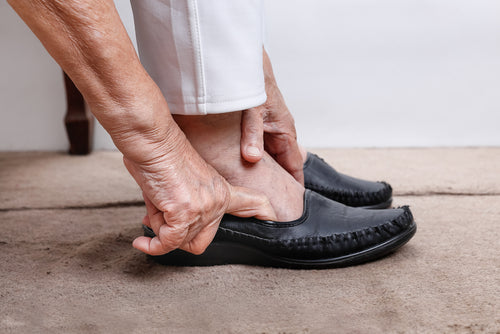Tips for Diabetic Foot Care: Cleaning Your Feet, Wearing Diabetic Socks and More
Diabetes is a serious condition that occurs when your blood glucose (a.k.a. blood sugar) is too high. It affects nearly a tenth of Americans: As of 2015, 30.3 million people in the United States, or 9.4 percent of the population, had diabetes. Over time, diabetes can lead to other complications such as heart disease, stroke, kidney disease, eye problems, dental disease, nerve damage and foot problems. Foot problems are especially common in diabetics, so we’ve put together a guide that offers our best tips for taking care of your feet if you have diabetes. Here are our seven best strategies:

1. Manage your diabetes with other lifestyle changes.
Taking care of your feet without addressing the other symptoms of diabetes won’t actually solve anything. Work with your doctor and the rest of your healthcare team to keep your blood glucose levels in your target range. Eat a good diet, stay hydrated and exercise regularly to promote a healthy lifestyle. Store your insulin properly, take it on schedule and talk to your doctor if you notice any changes. Be careful drinking alcohol since your liver is responsible for metabolizing it as well as regulating your blood glucose levels.
2. Examine your feet every day.
Diabetes can lead to nerve damage (officially called “diabetes neuropathy”), which reduces your ability to feel pain, especially in your extremities. As a result, you might hurt yourself and not realize it until you see the cut. To prevent this from happening, visually examine your feet every day for cuts, swelling, blisters, spots and other abnormalities. If you can’t see the bottom of your feet, use a mirror or ask someone you trust to look for you.

3. Clean and moisturize your feet every day.
Gently wash your feet with warm (not hot) water and mild soap every day. When you get out of the shower or tub, dry your feet well and make sure to get between the toes. Once your feet are dry, rub a thin coat of lotion over the tops and bottoms of your feet (but not between the toes). Special diabetic lotion will help keep your feet moisturized and comfortable and encourage the skin to repair and regenerate.
4. Be gentle with corns and calluses.
The need for a gentle approach goes back to the potential lack of feeling: While it is important to keep your feet smooth and soft, you don’t want to accidentally injure your feet by scrubbing them too hard. A pumice stone is a good option if you need to exfoliate your feet, but use it gently and watch what you’re doing at all times. Don’t try to shave off your calluses or otherwise treat your feet with sharp objects; leave that to a professional foot specialist instead.
5. Trim your toenails.
Keep an eye on your toenails’ growth rate and trim them as often as needed. Cut them straight across using clippers, and then file the edges until they are smooth using an emery board or a nail file. If you can’t reach your toes, ask your caretaker or home health aide to help you.

6. Protect your feet.
Never go barefoot, even when you’re inside. Wear diabetic socks to keep your feet dry and fight slow blood flow. Make sure your shoes fit comfortably, neither too tight nor too loose. Before putting on your shoes, check the insides to make sure there are no objects that might poke into your feet as you walk. If you have certain foot problems you need to accommodate, such as bunions, custom orthotics will give you the support you need while conforming to your unique foot shape.
7. Guard against hot and cold.
Also given the potential for neuropathy, diabetics can sometimes have trouble sensing hot and cold, which can lead to issues such as burns and frostbite. If you’re in an environment where the pavement is especially hot or cold—say, on a beach or the ski slopes—wear durable shoes that protect your feet. If your feet get cold at night, wear socks to bed as well. Test any water before submerging your feet in it.
Spending a few minutes a day to care for your feet can significantly improve your quality of life and foot health if you’re living with diabetes. Follow these seven best practices for diabetic foot care to stay healthy and take care of yourself.
Kaki Zell - Vice President of Sales, Marketing, eCommerce at Legs-4-Life LLC Kaki holds a Bachelor of Science degree in Business Administration and Management from Virginia Polytechnic Institute and State University. She’s been working in the medical device industry for over 11 years and currently serves on the Board of Directors for the Greensboro Science Center.
Written May 2019 | Page last updated May 2022
Sources:
Centers for Disease Control and Prevention. “Prevent Diabetes Complications” https://www.cdc.gov/diabetes/managing/problems.html
Mayo Clinic. “Diabetes Management: How Lifestyle, Daily Routine Affect Blood Sugar” https://www.mayoclinic.org/diseases-conditions/diabetes/in-depth/diabetes-management/art-20047963
National Institute of Diabetes and Digestive and Kidney Diseases. “Diabetic Neuropathy” https://www.niddk.nih.gov/health-information/diabetes/overview/preventing-problems/nerve-damage-diabetic-neuropathies
National Institute of Diabetes and Digestive and Kidney Diseases. “What is Diabetes?” https://www.niddk.nih.gov/health-information/diabetes/overview/what-is-diabetes